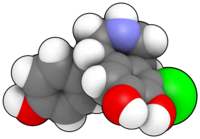Fenoldopam
 |
|
 |
|
| Clinical data | |
|---|---|
| Trade names | Corlopam |
| AHFS/Drugs.com | Monograph |
| Pregnancy category |
|
| Routes of administration |
IV |
| ATC code | |
| Legal status | |
| Legal status |
|
| Pharmacokinetic data | |
| Metabolism | Hepatic ( not involved) |
| Biological half-life | 5 minutes |
| Excretion | Renal (90%) and fecal (10%) |
| Identifiers | |
|
|
| CAS Number | |
| PubChem CID | |
| IUPHAR/BPS | |
| DrugBank | |
| ChemSpider | |
| UNII | |
| KEGG | |
| ChEBI | |
| ChEMBL | |
| ECHA InfoCard | 100.060.538 |
| Chemical and physical data | |
| Formula | C16H16ClNO3 |
| Molar mass | 305.76 g/mol |
| 3D model (Jmol) | |
| Chirality | Racemic mixture |
|
|
|
|
|
|
|
Fenoldopam mesylate (Corlopam) is a drug and synthetic benzazepine derivative which acts as a selective D1 receptor partial agonist. Fenoldopam is used as an antihypertensive agent. It was approved by the Food and Drug Administration (FDA) in September 1997.
Fenoldopam is used as an antihypertensive agent postoperatively, and also intravenously (IV) to treat a hypertensive crisis. Since fenoldopam is the only intravenous agent that improves renal perfusion, in theory it could be beneficial in hypertensive patients with concomitant renal insufficiency.
Fenoldopam causes arterial/arteriolar vasodilation leading to a decrease in blood pressure by activating peripheral D1 receptors. It decreases afterload and also promotes sodium excretion via specific dopamine receptors along the nephron. The renal effect of fenoldopam and dopamine may involve physiological antagonism of the renin-angiotensin system in the kidney. In contrast to dopamine, fenoldopam is a selective D1 receptor agonist with no effect on beta adrenoceptors, although there is evidence that it may have some alpha-1 and alpha-2 adrenoceptor antagonist activity. D1 receptor stimulation activates adenylyl cyclase and raises intracellular cyclic AMP, resulting in vasodilation of most arterial beds, including renal, mesenteric, and coronary arteries. to cause a reduction in systemic vascular resistance. Fenoldopam has a rapid onset of action (4 minutes) and short duration of action (< 10 minutes) and a linear dose response relationship at usual clinical doses.
Adverse effects include headache, flushing, nausea, hypotension, reflex tachycardia, and increased intraocular pressure.
...
Wikipedia
